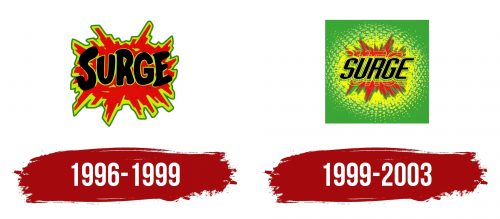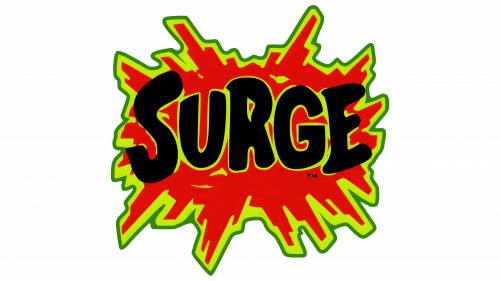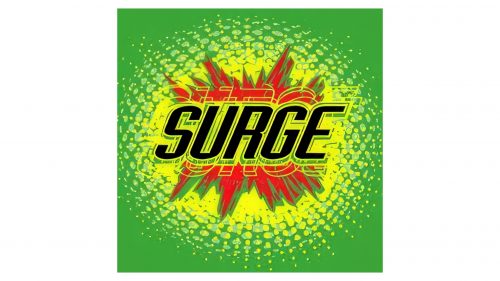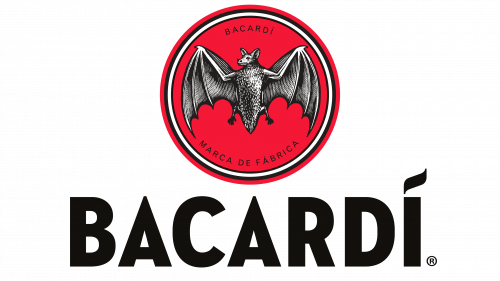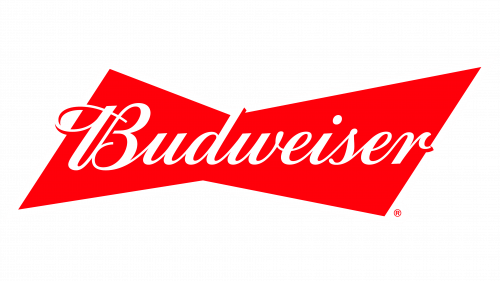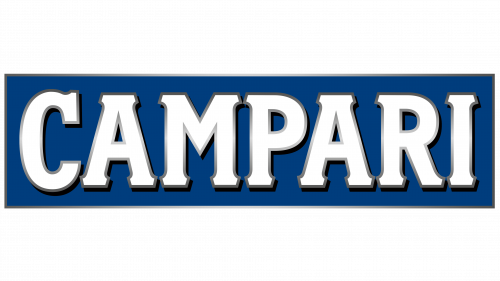The Surge logo is explosive, vibrant, noticeable, and easy to remember. Its design uses a wow effect, conveyed through its color scheme, bright details, and decorative elements. The logo embodies maximalism, extravagance, and boldness, attracting fans of unconventional products.
The creation of this drink went through several stages. Initially, the drink existed in Norway, but then a similar new product appeared from the competing company PepsiCo. After much deliberation, Coca-Cola decided to release its grand green drink.
Surge: Brand overview
The Coca-Cola Company chose to develop a new energy drink in 1996 to rival PepsiCo’s well-known Mountain Dew, which marked the beginning of Surge’s existence. The drink was developed under the code name “MDK,” or “Mountain Dew Killer,” which reflected the high standards of the business.
The official launch of Surge occurred in 1997. The beverage had a vivid green hue, a zesty flavor, and a high caffeine and carbohydrate content. The drink was supposed to deliver an energy boost, so the term “Surge” was chosen.
A significant advertising campaign targeting younger consumers supported the product’s release. The drink’s commercials were boisterous and violent, frequently showcasing extreme activities and adventures. “Feed the Rush” emerged as a crucial brand persona component.
The beverage became well-known quickly after its release, particularly among young adults and teenagers. It was marketed as a healthier substitute for regular sodas, providing a stronger taste and a surge of energy.
The product’s fame reached its height between 1998 and 1999. The beverage was extensively advertised on television, radio, and print media and sold in all 50 states. Coca-Cola also experimented with various cans and huge bottles as packaging.
However, sales started to drop in the early 2000s. This was caused by several things, such as shifting customer preferences and escalating rivalry in the energy drink sector. Concerns were also raised regarding the beverage’s high caffeine and sugar content.
Coca-Cola decided to stop selling the product in the US in 2003. Many devoted fans were disappointed by this move and started campaigns to have the drink back.
The beverage persisted in certain other nations under new names even after it was banned in the United States. For instance, it was marketed as Urge in Norway, where it remained well-liked.
Many fan initiatives to return the product to the market occurred years after its U.S. discontinuance. Consumers’ demand for their favorite drink to be returned was brought to Coca-Cola’s attention through online petitions, social media groups, and even crowdfunding initiatives.
Coca-Cola declared in 2014 that the drink would return to the United States following a ten-year absence. When it was first made available on Amazon, it was one of the first Coca-Cola products offered only online.
The brand’s resurgence was mostly propelled by fan engagement and nostalgia for the 1990s. Coca-Cola admitted that steadfast customer requests heavily impacted the drink’s choice to return.
After seeing great success with sales on Amazon in 2015, the product progressively returned to retail locations in a few U.S. states. Coca-Cola could gauge the drink’s long-term demand by taking its time and expanding cautiously.
The beverage’s availability considerably expanded in 2016 and 2017. It has started to be available in more places and different packaging, such as 16-ounce cans.
Coca-Cola increased its product reach in 2018, bringing the beverage to further areas of the United States. Sustained demand and favorable customer feedback prompted this choice. To keep consumers interested in the brand, the business has experimented with limited releases of new varieties.
In 2019, the beverage debuted in a brand-new form: frozen slush. With the launch of this product, the company expanded its consumer base and entered the fast-food industry. Frozen Surge gained popularity as a summertime beverage.
Coca-Cola continued investing in marketing in 2020, focusing on nostalgia for the 1990s. A digital campaign with retro-styled ads and interactive social media features was introduced to attract current and potential customers.
For the brand, 2021 was a year of innovation. The firm released a new drink called Zero Sugar in response to consumer demand for lower-calorie options. By making this change, the company could still compete in the diet energy drink market without sacrificing its distinctive flavor.
By introducing the Energy line in 2022, the brand increased its market share in the energy drink industry. These beverages positioned themselves as a more serious substitute for regular options for customers looking for a potent energy boost thanks to their greater caffeine content and extra energy ingredients.
Its emphasis on sustainability characterized 2023. The brand switched to more environmentally friendly packaging, such as aluminum cans instead of plastic bottles. This program was a component of Coca-Cola’s larger environmental impact reduction plan.
The brand also released a limited edition, “Throwback Edition,” in 2023, including the original 1990s packaging. This campaign aimed to draw collectors and strengthen the product’s nostalgic appeal.
To keep people interested in the product, the brand collaborated with influencers, arranged special events, and actively connected with followers on social media.
Meaning and History
What is Surge?
It is a citrus-flavored soft drink brand owned by The Coca-Cola Company. The brand is known for its bold flavor and high caffeine content, targeting a younger demographic due to its rich flavor and bright green packaging. It was originally marketed as an energy alternative to traditional sodas, which appealed to those looking for a more interesting beverage option. Although the drink was discontinued for a time, it has resurfaced due to its popularity and is now available at select stores and online retailers.
1996 – 1999
The bright citrus flavor of the green-colored drink caught the attention of Americans. People of different generations decided to try this sweet masterpiece. The demand was high, and the logo played a significant role in its popularity. It shone on bottles of the fizzy mix, resembling lightning flashes or the sparkle of fireworks.
The logo’s color scheme was not just bright but bold and striking. Against a red background, the black letters forming the word Surge stood out. All the letters were dark as night and uniform in size. The brand name was arranged dynamically, with each letter at a different height horizontally. The text had a bright and wide outline, creating an explosive effect and enhancing the visual impression. The same outline was used for the splotch, which the designers called a “large splash.” The color palette was powerful and rich, with clearly defined strokes and outlines in the logo.
1999 – 2003
1999, the identity underwent significant changes while retaining part of its previous color scheme. The logo remained three-colored, combining green, red, black, and yellow.
The primary light green background is now enclosed in a geometric square shape. In the center of the figure, “Surge” is written in capital letters. The black letters stand out against the background, while yellow creates an incredible 3D outline and shadow, adding dynamism to the inscription. It appears as if the letters are moving from the depth of the square beyond its boundaries.
Beneath the word “Surge,” a red tone is visible, representing splashes – a symbol of the product. Small splashes in dark and light yellow shades from another background enhance the visual effect and add dynamism to the logo.

